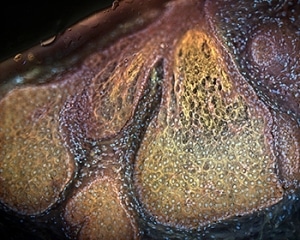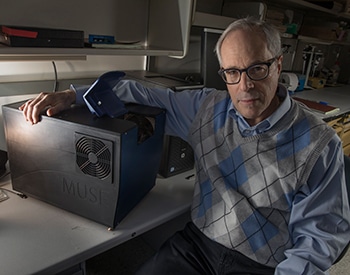Dec 5 2017
A microscope that uses ultraviolet (UV) light to illuminate samples allows pathologists to assess high-resolution images of fresh tissue samples, including biopsies, for various diseases within a matter of minutes, without damaging the tissue or requiring lengthy preparation of traditional slides.
 Credit: UC Davis
Credit: UC Davis
According to a study published in the journal Nature Biomedical Engineering, the new method could pave the way for the improvement of the efficiency and speed of medical research and patient care nationwide.
The technology, abbreviated to MUSE, which stands for microscopy with UV surface excitation, makes use of ultraviolet light at wavelengths below the 300 nanometer range to penetrate the exterior of the sample tissue by only a few microns (about the same thickness of tissue slices on conventional microscope slides.) The phenomenon was originally described by Stavros Demos, one of the co-authors and who is now at the University of Rochester.
Samples which are marked with eosin or other similar standard dyes to emphasize critical features such as cytoplasm, nuclei and extracellular components generate signals from the UV excitation that are bright enough to be detected by standard color cameras using sub-second exposure times. The process enables rapid imaging of large areas and instant interpretation.

Richard Levenson, professor and vice chair for strategic technologies in the Department of Pathology and Laboratory Medicine at UC Davis
MUSE eliminates any need for conventional tissue processing with formalin fixation, paraffin embedding or thin-sectioning. It doesn’t require lasers, confocal, multiphoton or optical coherence tomography instrumentation, and the simple technology makes it well suited for deployment wherever biopsies are obtained and evaluated.
Richard Levenson
The ability of MUSE to rapidly collect high-resolution images without damaging the tissue is a principal feature.
“It has become increasingly important to submit relevant portion of often tiny tissue samples for DNA and other molecular functional tests,” he said. “Making sure that the submitted material actually contains tumor in sufficient quantity is not always easy and sometimes just preparing conventional microscope slices can consume most of or even all of small specimens. MUSE is important because it quickly provides images from fresh tissue without exhausting the sample.”
The ability to acquire rapid, full-color images, high-resolution for pathology toxicology or histology studies is also valuable to basic researchers who wish to study tissue samples from experimental animal models at the laboratory bench. MUSE Microscopy Inc is commercializing this technology.
The research was partly supported by UC Davis Department of Pathology and Laboratory Medicine start-up funds, a UC Davis Science Translation and Innovative Research grant, and an unrestricted gift from Agilent Technologies.
The work was performed in part under the auspices of the US Department of Energy by the Lawrence Livermore National Laboratory under contract DE-AC52-07NA27344.